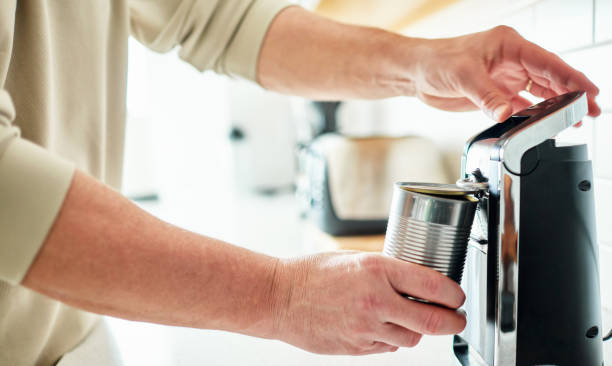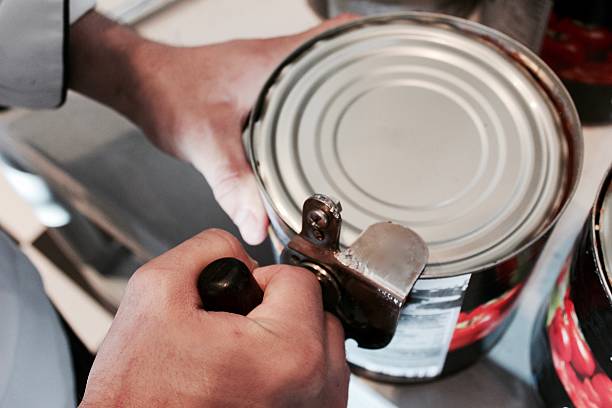How to Use Can Opener: With Different Types
Can openers are a basic but crucial kitchen appliance. Even if you have the best can opener, there’s a chance that you’ll visit a friend’s home or rental during a trip and find a completely foreign one. Fear not; we’ve provided instructions on how to use each type of can opener down below. To open cans safely and prolong the life of your can opener, adhere to these best-use care procedures.
How to Use a Handheld Can Opener
Although left-handed can openers are available from specialized retailers, it should be noted that the majority of handheld can openers are made for right-handed users.
- A flat countertop should be used for the can.
- The can opener’s arms are spread apart. The notched feed wheel and the sharp cutting wheel are separated in this way.
- synchronize the two wheels. On the right side of the can, with the knob outside, place the cutting wheel on top of the lid. Make sure the cutting wheel and feed wheel are parallel to the can’s side (not angled) and aligned.
- Combine the arms of the can opener. As the can lid is punctured by the cutting wheel, you should hear it.
- clockwise, turn the knob. The can’s lip will be grasped by the feed wheel, and the lid will be cut off by the opener. Turn the knob continuously until you’ve cut the lid completely around the can or only left a small portion uncut. (As you move all the way around the can, it will rotate.)
- Take care when removing the lid. Use a butter knife, being careful not to cut yourself on the can’s pointed edge.
How to Use a Smooth Edge Or Safety Can Opener
Similar to conventional handheld can openers, smooth-edge or safety can openers cut through the side of the can rather than the top.
- Put the can on a surface that is flat.
- Set the wheels in alignment. Set the cutting wheel on the can’s side and the notched feed wheel at the lid’s lip.
- Depending on the manufacturer, the can opener’s knob may be on the top or side. The opener will naturally rotate around the can as you remove the lid and open it.
- To take off the top, use the notch lid pliers. A thin metal ring will be severed by the can opener; grasp the lid with the pliers and take it off.
How to Use An Electric Can Opener
- The can opener needs to be plugged in.
- Set the can up so that it faces the opener. Raise the lever, align the can with the opening, and make sure the wheel and blades are parallel to each other.
- To secure the can, lower the lever. The magnet should rest on the top of the can lid, and the cutting blade should align with the inside of the lid.
- When you turn the power on, the can opener should automatically rotate the can after the cutting blade punctures the lid. To prevent spills, you might need to maintain a loose grip on the can as it rotates. The lid should be removed from the can after the can has finished rotating and cutting.
- In order to remove the can from the can opener, lift the lever while holding it.
- Dispatch the magnet’s lid.

How to Clean and Maintain a Can Opener
After each use, wash your can opener, and let it completely air dry before storing it. The following are general recommendations, but for the best use and maintenance procedures specific to your model, consult your user manual.
For Handheld Can Openers:
- The can opener should be cleaned by scrubbing it with dish soap and hot water using a sponge. Use a toothbrush or scrub brush to thoroughly clean the gears and both sides of the blade. Spread the handles of the can opener out on a fresh towel and let them air dry after drying the device with a dish towel. Rust can be avoided by completely drying the can opener before storing it.
- Can openers should not be placed in the dishwasher as this will result in rusty gears. The effectiveness of the can opener may be impacted by the dulling effect of dishwashing detergents on blades.
- For a few hours (or overnight, if it’s really rusted), soak your can opener in a jar or bowl of white vinegar or apple cider vinegar to remove any rust or gunk that has built up. With a toothbrush or small cleaning brush and some warm water, scrub the gears to get rid of the rust and gunk. Apply a small amount of dish soap or baking soda to the gears and scrub them once more if any residue is left. Once completely air dried, dry with a dish towel and allow to store.
- Applying food-grade mineral oil with a dishcloth on a regular basis will help your can opener operate more efficiently.
For Electric Can Openers:
- To clean, use a soft, damp cloth to wipe the can opener, and then dry it completely with a fresh, dry cloth.
- When cleaning rust or gunk, unplug the can opener and follow the manufacturer’s instructions if your model’s piercing lever or cutting wheel is detachable. Rinse and completely dry the piercing/cutting lever after washing it in hot, soapy water. Use a toothbrush dipped in baking soda to scrub away any built-up gunk or rust if the cutting wheel isn’t removable. Use a soft, damp cloth or wet paper towel to clean up, and then dry with a fresh, dry cloth.
How to Open a Can Without a Can Opener
Use a Spoon
Grab a big, strong spoon (preferably one made of stainless steel) by the base of the utensil (where the handle and spoon bowl meet). Rub the spoon bowl’s tip firmly inside the can’s rim with the other hand while holding the can. Rub the lid repeatedly in a small area until it gives. In order to remove the lid, keep going until you have a big enough gap. To avoid cutting yourself, be careful around any jagged edges.
Use a Screwdriver and Hammer
Use a flat-head screwdriver to make a hole big enough to pour the contents out of a can of liquid (such as soup or coconut milk) before opening it. With one firm hand, line up the screwdriver along the can’s rim. To pierce the metal, tap the top of the screwdriver handle with the hammer while holding the tool in your opposite hand.
Use a Pocketknife Or Box Cutter
Use this technique with extra caution! Use a box cutter or a pocketknife with a pointy blade to pierce the top of the can, then work your way around the edge until you can pry it open (wear dish gloves or cover your hands with kitchen towel to prevent cuts from the sharp edges).
Conclusion: a Steady Way
When opening anything from the smallest soup can to the largest milk can, can openers were the reliable choice. They are useful when you need to prepare some canned meat or vegetables but are stuck.

